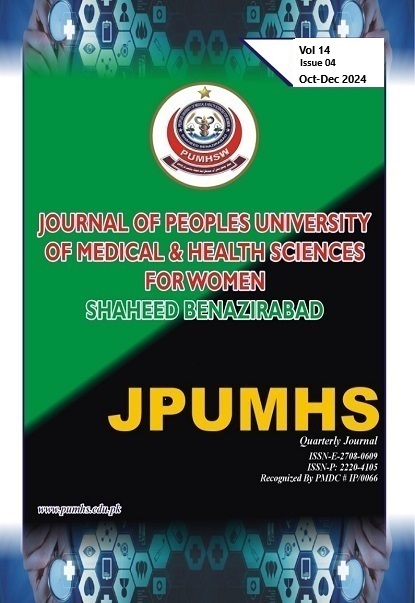PREVALENCE AND HISTOPATHOLOGICAL PATTERN OF HELICOBACTER PYLORI IN PATIENTS PRESENTING WITH GASTROINTESTINAL SYMPTOMS: A CLINICAL STUDY.
JPUMHS;2024:14:04,32-40. http://doi.org/10.46536/jpumhs/2024/14.04.558
Keywords:
Helicobacter pylori, Histopathological patterns, Gastrointestinal symptoms, Gastritis, HistopathologyAbstract
BACKGROUND: Gastritis, peptic ulcers, and the possibility of developing into cancer are
among the gastrointestinal conditions that are significantly influenced by Helicobacter pylori
H. pylori. This study aimed to evaluate the prevalence of H. pylori and its associated
histopathological findings in patients with gastrointestinal symptoms. OBJECTIVE: To
assess the prevalence of H. pylori and association with histopathological findings among
gastrointestinal symptomatic patients. METHODS: A descriptive cross-sectional study
conducted at Khyber Teaching Hospital, Peshawar. About 310 patients were enrolled using
non-probability convenient sampling technique. H. pylori stool antigen testing and
histological analysis of stomach biopsy samples were examined. Data collected was analyzed
by SPSS version 22, with p <0.05 considered significant. RESULTS: In this study, 310
patients were assessed, comprising 171 females 55.2% and 139 males 44.8%. The highest
infection rates were observed in the age groups of 31 to 45 18.3% and 19 to 30 15.0%, with
an overall positive rate of 16.4%. Histopathological analysis revealed that 134 patients
43.23% had chronic non-specific gastritis, while 140 cases 45.16% presented with
Helicobacter pylori-associated pangastritis. There was a significant correlation of H. pylori
with histopathological severity was observed p=0.012. However, no significant association of
stool antigen test with age p=0.946 and gender p=0.377 was observed. CONCLUSION:
Pangastritis and chronic gastritis are the main symptoms of the extremely common
Helicobacter pylori infection. Early identification and treatment are essential to prevent
complications, even though severe results such as MALT lymphoma are uncommon.
Controlling the risks of infection requires routine screening.
Downloads
Downloads
Published
How to Cite
Issue
Section
License

This work is licensed under a Creative Commons Attribution-NoDerivatives 4.0 International License.




